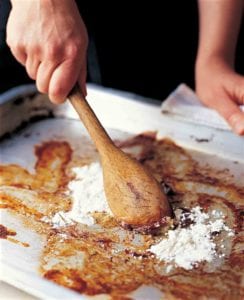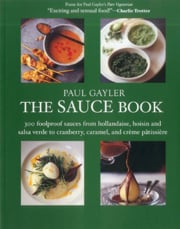: gravy consisting of seasoned but not thickened juices extracted from meat in cooking and often a little water.

Can I make pan gravy from brined meat?
Wondering how to make gravy from a brined cut of meat? The short answer is don’t even try. Seriously. The saltiness in the pan drippings will truly overpower everything else in your gravy. Sorta like a narcissist dominating the conversation at a cocktail party. There’s just no chance of salvaging the situation. Don’t even bother.

- ▢ Roasting pan with the drippings, from a roast beef, chicken, turkey, guinea hen, pork loin, or other cut of meat (NOT a brined cut of meat)
- ▢ 3 tablespoons all-purpose flour
- ▢ 2 1/2 cups homemade stock, warmed (use a chicken stock for roast chicken, turkey stock for turkey, beef stock for roast beef, and so on)
- ▢ Salt and freshly ground black pepper
- After roasting the meat, transfer it to a warmed platter or plate and set aside to rest.
- Skim the excess fat from the surface of the liquid that collected in the roasting pan, leaving about 2 tablespoons juices mingled with a little fat. Place the roasting pan over 1 or 2 burners on medium heat. Using a wooden spoon, scrape up the caramelized pan juices, then sprinkle the flour over the top, stirring constantly to blend it well with the fat and juices. Cook, still stirring constantly, until the flour becomes a light golden color, about 2 minutes.
- Still stirring, slowly add the warm stock to the roasting pan. Bring to a boil and cook—say it with us, still stirring constantly—until the sauce thickens and the mixture is reduced by about a third and has a gravylike consistency. Season the gravy with salt and pepper to taste. If desired, strain through a fine-mesh strainer. Serve immediately.

Nutrition information is automatically calculated, so should only be used as an approximation.
I think this is a great basic pan gravy to keep on hand when you make any roast item that needs a gravy. This would make a super easy Thanksgiving gravy as well as Easter roast gravy or anything else. I didn’t try any of the variations, but I think that each would work great!
This is a great way to make pan gravy for a roast—even if you don’t have enough drippings. The roast I cooked didn’t surrender enough drippings, so I improvised by adding some butter. Sure enough, the roux yielded a fantastic sauce for our roast beef. I used the wine variation, adding 1/2 cup port for a well-rounded gravy, and everyone loved it.
This pan gravy is foolproof, easy, and has demonstrated that it’s really versatile.
My slightly alternative approach was to substitute the braising liquid from a big pile of short ribs for the roast pan drippings. I chose the herb and mustard variation. I added a heaping tablespoon of chopped fresh herbs rather than a small handful of dried herbs. It tasted perfect, and I didn’t have to strain the herbs out.
This is a nice way to end up with pan gravy after making any of a wide variety of roast meats, poultry, or game. It’s pretty straightforward and open to many variations. I tried a beer gravy to use up the rest of the bottle of beer I had opened when making the Wheat Beer Chicken.
I had some beautiful fresh thyme, so I added that to the gravy also. I cooked some vegetables and used the leftover chicken and gravy to make a crustless chicken potpie. There are even leftovers for tomorrow, all after having a nice amount of gravy to begin with.
I count myself lucky to have received three James Beard Awards for my writing as well as for Leite’s Culinaria. My work has also appeared in The New York Times, Martha Stewart Living, Saveur, Bon Appétit, Gourmet, Food & Wine, Yankee, Los Angeles Times, Chicago Tribune, The Washington Post, and more.
Hi, I’m David Leite
I’m a three-time James Beard Award-winning food writer, cookbook author, memoirist, podcast host, and publisher. For the past 24 years, I’ve been cooking, teaching, and writing about all types of food, including those from my Portuguese heritage. Let’s eat! Vamos comer!
How to Make Classic Pan Gravy | Thanksgiving Recipes | The New York Times
FAQ
What is pan gravy made of?
What kind of sauce is pan gravy?
Is pan sauce the same as gravy?
What are pan drippings?
What is pan gravy used for?
It’s usually, and delectably, poured on top of side dishes like mashed potatoes or roasted vegetables . Easy to make, our pan gravy makes the best of the flavorful bits and juices remaining in the bottom of a pan after roasting a turkey, a chicken, a rack of pork, or a beef roast, amongst other delicious meat cuts.
What is a basic pan gravy?
This basic pan gravy is a foolproof lesson that teaches you how to make any kind of gravy using three ingredients: pan drippings, flour, and stock. A must for Thanksgiving, Christmas, Easter, and Sunday supper. This post may contain affiliate links. If you make a purchase, we may make a small commission. This basic pan gravy is a cinch to make.
How to cook pan gravy at home?
To cook pan gravy at home, start by removing the cooked meat or vegetables from the pan and placing it on a serving dish. Next, place the pan on medium heat and add a tablespoon of butter or oil to the drippings. Once the fat has melted, sprinkle a tablespoon of flour into the pan and whisk it for a minute until it forms a paste.
What is mushroom pan gravy?
In Italy, mushroom pan gravy, or funghi trifolati, is a popular variant that is generally comprised of olive oil, garlic, white wine, and mushrooms, while the French make their pan gravies using butter, shallots, and white wine. Even in Asia, where pan gravies are not as common, variations of soy sauce and ginger are used to flavor pan sauces.
